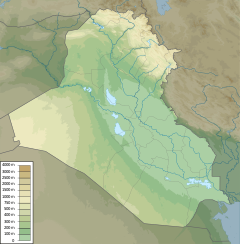| Kirkuk Massacre | |
|---|---|
 The old part of Kirkuk, where the massacre took place | |
| Location | Kirkuk, Mandatory Iraq |
| Coordinates | 35°28′N 44°24′E / 35.47°N 44.4°E |
| Date | May 4, 1924 |
Attack type | Shooting, Mass shooting, Mob violence, Looting |
| Weapon | Rifles |
| Deaths | 200-300 |
| Perpetrator | Assyrian levies |
The Kirkuk Massacre of 1924 was a massacre towards the people of Kirkuk by the Assyrian Levies on May 4, 1924 after the Assyrian Levies were attacked in Kirkuk in 1924 and in previous years after settling in Iraq.[1][2][3][4][5] One notable attack which led to hostility between the Assyrians and Turkmens was in August 1923 in Mosul in which two Assyrian children were killed by Muslims and no one was brought to justice.[6]
In early 1924 the British deployed the Assyrian levies to Kirkuk province in order to capture the city of Sulaymaniyah, which was controlled by Kurd Sheikh Mahmud.[7][8] The Muslimd in Kirkuk threatened to attack Assyrian women as soon as the Assyrian Levies left Kirkuk to Sulaimanya.[9]
On 4 May, an argument broke out between an Assyrian Levie and a Turkmen shopkeeper in Kirkuk's central market over prices which led to physical fighting.[10][11] After the dispute, two more Assyrian Levies were wounded by Turkmens after they were hit from behind with heavy sticks during a dispute.[12] The Turkmens were also taunting the Assyrians stating, "Now that half of you have gone to Chemchemal; we are not frightened of you."[13] According to British documents, "Two Assyrian battalions then went back to the town, on the way they savagely assaulted number of Turkmens sitting in coffee shop, destroying furniture and beating the customers."[14][15] This was done after Turkmens in the shop were making remarks towards the Assyrians who were passing by which started a riot between the Assyrians and Turkmens.[16] The Turkmens of Kirkuk then began shooting at the Assyrians which resulted in several Assyrian deaths.[17] The Assyrians Levies returned fire on the armed Turkmens which resulted in 200-300 Turkmens in Kirkuk being killed.[18] The total number of Assyrians killed was 5.[19]
See also
References
- ^ British Documents on Foreign Affairs--reports and Papers from the Foreign Office Confidential Print: The expansion of Ibn Saud, 1922-1925. University Publications of America. 1985. pp. 12–13. ISBN 978-0-89093-603-0.
on 4th May, however, inhabitants of Kirkuk were the victims of an atrocious massacre perpetrated by Assyrian levies, which has changed whole situation.
- ^ Great Britain, Colonial Office (1927). Report by His Britannic Majesty's Government to the Council of the League of Nations on the Administration of Iraq. p. 21.
- ^ Great Britain, Colonial Office (1925). Iraq, Report on Iraq Administration. H.M. Stationery Office. p. 29.
- ^ Salt, Jeremy (2008). The Unmaking of the Middle East: A History of Western Disorder in Arab Lands. Univ of California Press. p. 108. ISBN 978-0-520-26170-9.
- ^ Rush, Alan de Lacy; Priestland, Jane (2001). Records of Iraq, 1914-1966: 1921-1924. Archive Editions. p. 86. ISBN 978-1-85207-820-1.
- ^ Browne, John Gilbert (1932). The Iraq Levies, 1915-1932. Iraq: Royal United Service Institution. p. 34.
- ^ Jackson, Robert (1985). The RAF in Action: From Flanders to the Falklands. Blandford Press. p. 20. ISBN 978-0-7137-1419-7.
- ^ Great Britain, Colonial Office (1930). Report by His Britannic Majesty's Government to the Council of the League of Nations on the Administration of Iraq. p. 31.
- ^ Browne, John Gilbert (1932). The Iraq Levies, 1915-1932. Iraq: Royal United Service Institution.
- ^ Fuccaro, Nelida (2016-03-09). Violence and the City in the Modern Middle East. Stanford University Press. p. 184. ISBN 978-0-8047-9776-4.
- ^ Sonyel, Salahi Ramadan (2001). The Assyrians of Turkey: Victims of Major Power Policy. Turkish Historical Society. p. 177. ISBN 978-975-16-1296-0.
- ^ Browne, John Gilbert (1932). The Iraq Levies, 1915-1932. Iraq: Royal United Service Institution. p. 35.
- ^ Browne, John Gilbert (1932). The Iraq Levies, 1915-1932. Iraq: Royal United Service Institution. p. 35.
- ^ British Documents on Foreign Affairs--reports and Papers from the Foreign Office Confidential Print: The expansion of Ibn Saud, 1922-1925. University Publications of America. 1985. p. 13. ISBN 978-0-89093-603-0.
- ^ Browne, John Gilbert (1932). The Iraq Levies, 1915-1932. Royal United Service Institution. pp. 34–5.
- ^ Browne, John Gilbert (1932). The Iraq Levies, 1915-1932. Royal United Service Institution. p. 35.
- ^ Browne, John Gilbert (1932). The Iraq Levies, 1915-1932. Royal United Service Institution. p. 35.
- ^ Browne, John Gilbert (1932). The Iraq Levies, 1915-1932. Iraq: Royal United Service Institution. p. 36.
- ^ Browne, John Gilbert (1932). The Iraq Levies, 1915-1932. Iraq: Royal United Service Institution. p. 36.

